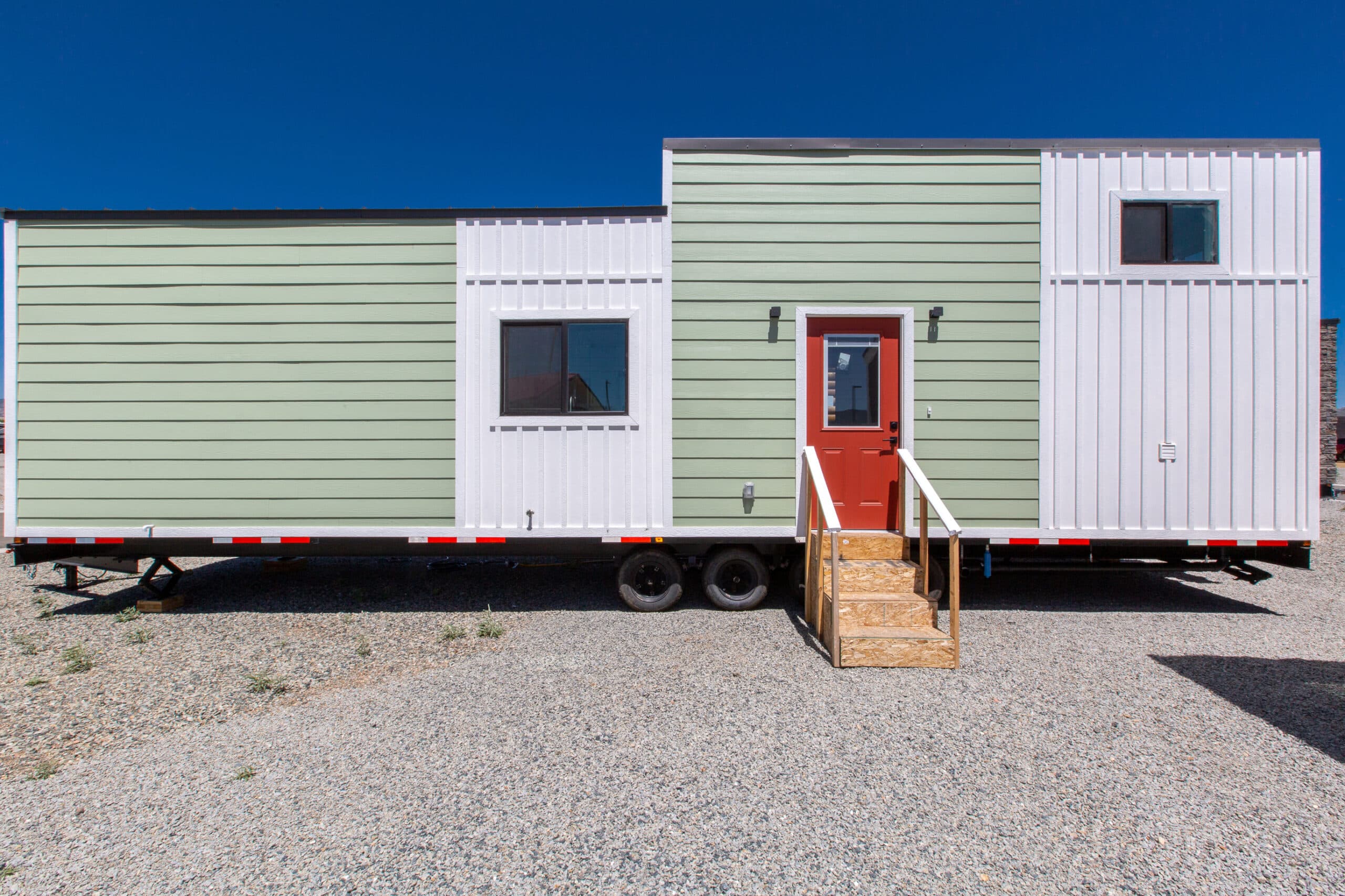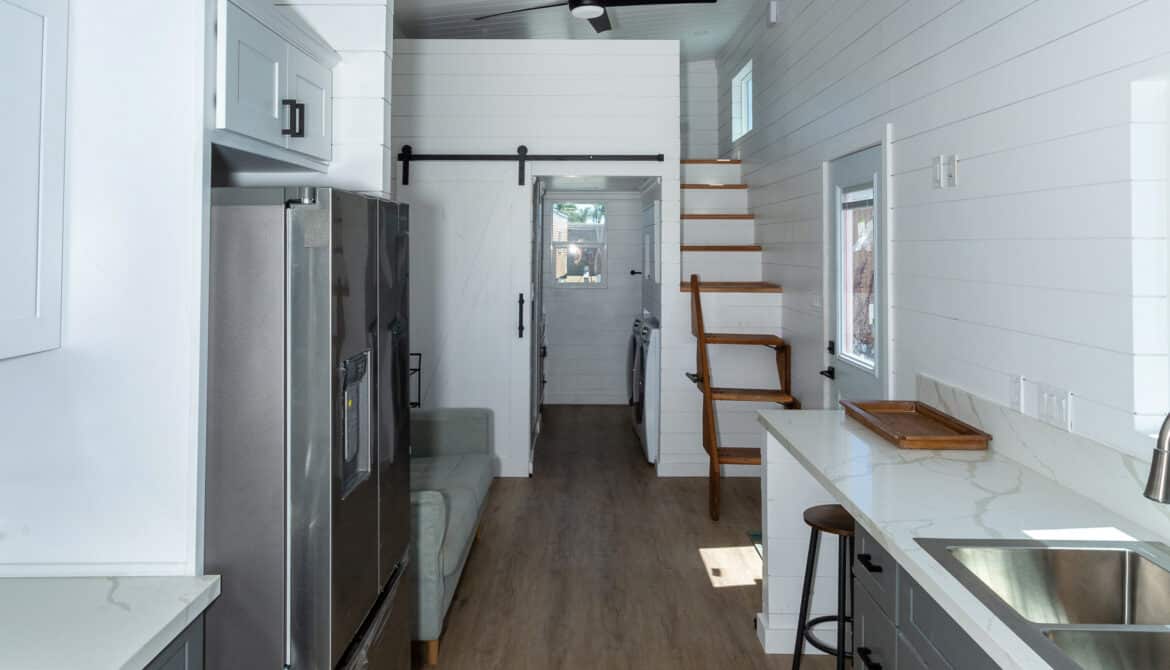Table of Contents
Introduction
A tiny house is a small dwelling, typically ranging from 100 to 400 square feet. It can be built on wheels or a foundation and is a popular housing choice for those who want to downsize their living space and live more sustainably. Tiny houses are becoming increasingly popular for people looking to reduce their environmental impact, save money, and simplify their lives.
Definition of Tiny House
Tiny houses are generally defined as dwellings that are less than 500 square feet in size. They often feature one or two bedrooms, a kitchen, a bathroom, and a living area. Some tiny houses may also include additional amenities such as a deck or porch, storage space, or even an outdoor shower.
Benefits of Tiny House Living
Living in a tiny house offers numerous benefits including lower costs, increased freedom, and reduced environmental impact. With smaller living spaces come fewer possessions which can lead to simpler and more meaningful lives. Additionally, many tiny homes are designed with eco-friendly features such as solar panels and composting toilets which help to minimize the environmental impact of the home. Finally, since tiny houses are smaller than traditional homes they require less energy for heating and cooling which can result in significant savings on utility bills.
Tips to Make Your Tiny House a Reality
A tiny house is a small dwelling that is typically built on wheels, making it more mobile than traditional housing. It offers many benefits, such as affordability, minimalism, and environmental sustainability. If you’ve been considering building your own tiny house, here are some tips to make it a reality.
Create a Mood Board
The first step in creating your dream tiny house is to create a mood board. This will help you visualize what you want the final product to look like. Gather images of designs and materials that inspire you and create an online or physical board that reflects your vision for your tiny home. Consider colors, textures, lighting fixtures, furniture pieces, and any other design elements that appeal to you. You can also use this mood board to start researching which materials and products are available that match your desired aesthetic.

Consider Your Lifestyle
When designing your tiny home, consider how you plan on living in it. Think about the activities you enjoy doing on a daily basis and how they might be incorporated into the design of the space. For example, if you enjoy cooking or baking, make sure there is enough counter space for prepping meals or rolling out doughs. If you like to entertain guests regularly, consider adding fold-out furniture pieces or removable tables so that people have enough seating when visiting. Taking into account how you live will help ensure that your tiny home meets all of your needs without feeling cramped or cluttered.
Make a Detailed Plan
Before starting construction on your tiny house, make sure to create a detailed plan of action with clear goals and timelines for each step of the process. Include everything from ordering materials to applying for permits and setting up utilities in the plan so that nothing gets missed during the build-out process. Having a well-thought-out plan will also help keep costs low by preventing costly mistakes along the way.
Choose Quality Materials
When selecting materials for your tiny house build-out, choose quality over quantity whenever possible. Investing in high-quality items now can save time and money down the line since they are less likely to need repairs or replacements later on. For example, instead of buying cheap particleboard cabinets for the kitchen area, opt for real wood cabinets with dovetail joints since they will last longer and look better over time.
Utilize Small Businesses for Help
If you’re not comfortable taking on every aspect of constructing your tiny house yourself, consider utilizing local small businesses who specialize in certain areas of expertise such as carpentry or plumbing installation. This can save time while also ensuring that everything is done correctly since these businesses have experience working with similar projects before. Plus, hiring local businesses helps support local economies which is always beneficial!
Research Local Regulations and Permits
Before beginning construction on your tiny house project it’s important to research local regulations and permits related to building structures on wheels in order to avoid any legal issues down the line. Every state has different laws regarding mobile homes so make sure you understand what’s required before getting started with construction so that everything is up to code when finished!
Create a Mood Board
Creating a mood board is the first step to making your tiny house dream a reality. A mood board is a collection of images, colors, and materials that represent your style and vision for the final product. It can be helpful to look through magazines, catalogs, and websites to find ideas that you like before creating your own mood board.
Once you have gathered some inspiration, you can start to create your own mood board. You can use physical items such as fabric swatches or paint chips, or digital tools like Pinterest or Canva to create an online mood board. This will help you visualize how different elements will work together in your tiny house design.
It’s important to remember that a mood board doesn’t have to be perfect; it’s just meant to give you an idea of what kind of design direction you want to go in when building your tiny house. Additionally, it can be helpful to talk with friends and family about their thoughts on the design before making any major decisions.
Consider Your Lifestyle
Living in a tiny house requires a lifestyle change, and it’s important to think through the implications of that before you start building. Start by making a list of your daily routines and needs, as well as any hobbies or activities that you enjoy doing. Think through what items are essential for your day-to-day life and how much space those items will take up.
Additionally, consider what kind of lifestyle adjustments you are willing to make. Are you comfortable with having less storage space? Do you have access to outdoor spaces where you can store seasonal items? Can you handle living in a small space with other people?
Adapting Your Habits
Living in a tiny house also means adapting some of your habits. This could include anything from cutting back on material possessions, learning how to downsize, or simply being more mindful of the energy and resources you use.

If possible, try living in a smaller space before committing to building a tiny house. This will help give you an idea of what it’s like to live in a confined area with limited amenities and help determine if this is the right choice for you.
Compromise
Finally, be prepared to compromise when it comes to designing and building your tiny house. You may not be able to include all the features that you had originally planned due to size constraints or budget limitations. Be flexible and open-minded when it comes to making decisions about your tiny home so that it becomes the perfect sanctuary for you.
Make a Detailed Plan
Creating a detailed plan for your tiny house is essential for successful construction. First, create a budget and timeline that you are comfortable with. This will determine the materials and labor you can afford as well as the amount of time it will take to complete the project. Then, research building codes and zoning regulations in your area to ensure that your tiny house complies with local laws. Additionally, consider any special needs you may have such as insulation or plumbing requirements.
Choosing Materials
When selecting materials, prioritize quality over quantity so that your tiny house lasts longer and is more comfortable to live in. Consider the climate in which you will be living and choose materials accordingly – for example, if you live in an area with extreme temperatures, make sure to invest in quality insulation and windows that will provide adequate protection from the elements. Also, don’t forget to factor in costs for appliances such as refrigerators, stoves, and washing machines.
Hiring Help
If you are not experienced in construction or design, consider hiring a professional who can help you bring your vision to life. Small businesses often specialize in tiny houses and can provide valuable advice on how to best utilize space while staying within budget. They can also help you navigate any legal issues related to permits or building codes. Finally, if possible enlist friends or family members who may be willing to lend a hand during construction – having extra hands on deck can speed up the process significantly!
Choose Quality Materials
When building a tiny house, it is important to choose quality materials that will stand up to wear and tear and last for many years. This is especially true when considering the foundation, walls, roof, and flooring of your tiny home.
Foundation
The foundation of your tiny home should be made from durable materials such as concrete or treated lumber. Concrete is the most popular option as it is strong and long-lasting. It also provides an excellent base for attaching other components of your tiny house.
Walls
The walls of your tiny home should be made from durable materials such as plywood, OSB (oriented strand board), or metal siding. Plywood is the most common choice as it is strong and lightweight while still providing insulation and soundproofing qualities. OSB is also a good option, though it can be more expensive than plywood. Metal siding can provide a modern look but may require additional insulation for energy efficiency.
Roof
The roof of your tiny home should be made from durable materials such as metal or asphalt shingles. Metal roofs are more expensive but offer superior protection from the elements and are highly resistant to fire. Asphalt shingles are less expensive but require regular maintenance to ensure they remain in good condition over time.
Flooring
The flooring of your tiny home should be chosen carefully as it must withstand frequent use and exposure to moisture. Laminate flooring is an affordable option that provides a great look while being easy to clean and maintain. Vinyl plank flooring is another popular choice as it offers durability and water resistance while still providing a stylish look.
When choosing materials for your tiny house, it is important to consider both quality and cost so you can get the best value for your money. Taking the time to research different options will help ensure that you make an informed decision that will serve you well for many years to come!
Utilize Small Businesses for Help
When building a tiny home, it can be beneficial to utilize small businesses in the area for help. many local businesses specialize in helping people build their dream tiny homes, and they can provide valuable assistance throughout the process. Working with a small business can help ensure that the project is completed on time and within budget.
1. Find Local Specialists
The first step is to research local specialists who have experience working with tiny houses. This can be done online or by asking around in the community. Once potential specialists have been identified, it is important to read reviews and speak with past clients to get an idea of their work quality and customer service.
2. Discuss Your Plans
After selecting a few potential specialists, it is important to discuss your plans in detail with them. They will be able to assess the project and provide feedback on what materials are needed, how long it will take, and any other considerations that need to be made. This conversation should also include discussing a budget so that everyone is on the same page about costs.
3. Get Everything in Writing
Once all of the details have been discussed, it is important to get everything in writing before beginning the project. This includes signing a contract that outlines all of the terms and conditions of working together, as well as any payment schedules or deadlines that need to be met. By getting everything in writing beforehand, it will help avoid any misunderstandings or issues down the road.
By utilizing small businesses for help when building a tiny home, you can ensure that your project runs smoothly from start to finish. It is important to do your research beforehand so that you are working with experienced professionals who understand your needs and goals for the project. With careful planning and consideration, you can make sure that your dream tiny home becomes a reality!
Research Local Regulations and Permits
Before starting the building process, it is important to research local regulations and permits that must be obtained in order to construct a tiny house. Depending on the area you live in, there may be zoning laws or other restrictions that could prevent you from building a tiny house. Additionally, some areas may require special permits for certain types of construction, such as electrical work or plumbing.
Check Zoning Laws
The first step is to check with your local zoning office to see if tiny houses are allowed in your area. Some cities and towns have specific rules about how small a structure can be before it is considered a permanent residence, so make sure to familiarize yourself with these regulations before you begin building.
Secure Necessary Permits
Once you have determined that it is legal to build a tiny house in your area, you will need to secure any necessary permits for the project. This could include electrical permits, plumbing permits, or even a building permit depending on the scope of the project. Make sure to contact your local authorities to determine which permits are required before beginning construction.
Researching local regulations and permits before building your tiny home is essential for ensuring that your project is completed legally and safely. By taking the time to understand the rules and regulations in your area, you can save yourself time and money in the long run by avoiding costly mistakes or delays due to incorrect paperwork or lack of proper permitting.
Mistakes to Avoid When Building Your Tiny Home
Building a tiny home is an exciting endeavor, but there are many mistakes that can be made along the way. Knowing what to avoid when constructing your tiny home will help you create the perfect house for your lifestyle and needs.
Not Having a Clear Vision for the Final Product
When building a tiny home, it’s important to have a clear vision of what your end goal should look like. Before you start building, make sure you have plans drawn up or at least know what kind of materials and design elements you want to use. If you don’t have a clear idea of what your tiny home should look like, it will be difficult to create the perfect space.
Not Considering Daily Routines and Needs
When designing your tiny home, it’s important to consider how you will use it on a daily basis. Think about how much storage space you need, where appliances will go, and any other items that are essential for your daily routine. If you don’t plan ahead for these items, it may be difficult to fit them into your tiny home later on.
Choosing Low-Quality Materials
It can be tempting to save money by choosing low-quality materials for your tiny home, but this could lead to costly repairs down the line. Investing in quality materials is essential for creating a long-lasting and comfortable living space. Make sure all materials used are durable and able to withstand wear and tear over time.
Building a tiny home is an exciting opportunity, but there are some mistakes that should be avoided when constructing it. By having a clear vision of the final product, considering daily routines and needs, and investing in quality materials, you can create the perfect tiny home for yourself or another family member.


